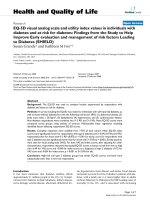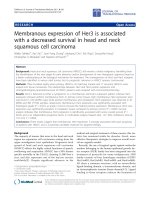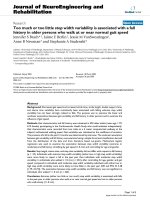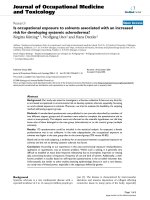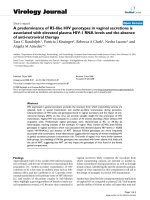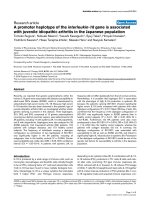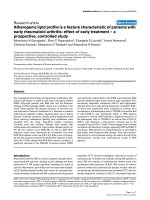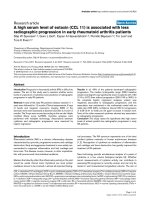Is small size at birth associated with early childhood morbidity in white British and Pakistani origin UK children aged 0–3? Findings from the born in Bradford cohort study
Bạn đang xem bản rút gọn của tài liệu. Xem và tải ngay bản đầy đủ của tài liệu tại đây (956.89 KB, 10 trang )
West et al. BMC Pediatrics (2018) 18:22
DOI 10.1186/s12887-018-0987-0
RESEARCH ARTICLE
Open Access
Is small size at birth associated with early
childhood morbidity in white British and
Pakistani origin UK children aged 0–3?
Findings from the born in Bradford cohort
study
Jane West1,2* , Brian Kelly1, Paul J. Collings1, Gillian Santorelli1, Dan Mason1 and John Wright1
Abstract
Background: Low birthweight is associated with increased infant morbidity, poorer developmental outcomes and
risk of adult disease and its prevention remains a public health priority. South Asian children are more likely to be
born small and there is some debate around whether this is a normal phenomenon within this population or
whether they have a greater risk of morbidity. We examined the association between small size at birth and morbidity
in White British and Pakistani origin children aged 0–3 participating in the Born in Bradford cohort study.
Methods: We included 4119 White British and 4731 Pakistani origin children and examined health service use (General
Practitioner (GP) consultations, the most common prescribing categories (analgesics, antibiotics, bronchodilators),
emergency and elective hospital episodes) as markers of morbidity, in children born small defined as: (i) low
birthweight (< 2500 g) (ii) small for gestational age (SGA) using customised birth charts. We used negative binomial
regression models to predict the adjusted incidence of morbidity markers.
Results: 8.7% of Pakistani and 5% of White British children were born with a low birthweight (< 2500 g). Using
customised charts, these proportions were 15.3 and 6.2% respectively. Children born small in both groups irrespective
of the criteria used, generally had a higher rate of episodes for morbidity markers compared to normal weight children.
Incidence of GP consultations (IRR 1.48 (95% CI 1.27, 1.73) to 1.55 (95% CI 1.36, 1.76) depending on birthweight category)
, analgesic (IRR 1.76 (95% CI 1.37, 2.25) to 2.31 (95% CI 2.19, 2.45) and antibiotic prescriptions (IRR 1.13 (95% CI 0.08, 1.46)
to 1.38 (95% CI 1.30, 1.48) and emergency hospital episodes (IRR 1.20 (95% CI 1.06, 1.36) to 1.46 (95% CI 0.92, 2.32), was
higher in Pakistani origin children with either a low or normal birthweight.
Conclusion: Being born small is associated with greater morbidity estimated by use of health services, in both White
British and Pakistani origin children underlining the importance of public health policy to reduce low birthweight.
Pakistani origin children access health services more frequently than White British children irrespective of birthweight
and this has implications for health service planning in areas with South Asian populations.
* Correspondence:
1
Bradford Institute for Health Research, Bradford Royal Infirmary, Duckworth
Lane, Bradford BD9 6RJ, UK
2
School of Social & Community Medicine, University of Bristol, Bristol, UK
© The Author(s). 2018 Open Access This article is distributed under the terms of the Creative Commons Attribution 4.0
International License ( which permits unrestricted use, distribution, and
reproduction in any medium, provided you give appropriate credit to the original author(s) and the source, provide a link to
the Creative Commons license, and indicate if changes were made. The Creative Commons Public Domain Dedication waiver
( applies to the data made available in this article, unless otherwise stated.
West et al. BMC Pediatrics (2018) 18:22
Background
Birthweight reflects intrauterine growth and wellbeing
and is recognised globally as an indicator of infant, child
health and increasingly adult health [1]. A low birthweight
(< 2500 g) has previously been associated with increased
infant mortality and morbidity [2, 3], poorer education
outcomes and developmental delay in childhood [4, 5]
and an increased risk of adult disease [6] via a range of
programming mechanisms. It has been suggested that one
such mechanism is the potential for reduced immune
function [7] and an inverse association between birthweight and infection related morbidity has been identified
in children up to the age of 14 [8], and there is some
evidence of longer term effects of birthweight on the
immune system where antibody response to vaccination
in teenagers and adults is lower in those who were small
at birth [9, 10]. Worldwide mean birthweight is lower and
the incidence of low birthweight higher among South
Asian origin populations when compared to White US/
European populations [11, 12]. In South Asia, this is in
part thought to reflect environmental exposure to poverty
and poor nutrition. However, babies born in high income
countries such as the UK, to mothers of South Asian
origin are considerably lighter (around 200-300 g) than
babies born to White British mothers and this difference
does not appear to reduce over subsequent generations of
UK South Asians [13, 14]. This has led to the suggestion
that differences may not be expressions of growth restriction but rather are genetically or culturally programmed
[15–17], and in the absence of environmental risk factors,
may not necessarily lead to increased mortality or morbidity i.e. some South Asian infants may be small and healthy
rather than small and at risk. Whether it can be proven
that smaller size is a normal phenomenon within South
Asians or not, the important question is whether the risks
of greater mortality or morbidity arising from smaller
birth size still apply. Customised growth charts have been
developed that take into account ethnicity and other
maternal factors [15] but when these have been evaluated
in terms of neonatal risk, there is no strong evidence that
these better predict the risk of adverse outcomes than
population based charts [18]. Whether this is also the case
beyond the neonatal period, to our knowledge remains
unclear.
Our aim in this paper was to examine the association
between being born small and early childhood morbidity
estimated using use of health services information for
White British and Pakistani origin children aged 0–3
participating in the Born in Bradford (BiB) cohort study.
We chose GP prescribing as a marker of morbidity and
selected the three most common prescribing categories:
analgesics, antibiotics and bronchodilators, where analgesics was the most common category followed by antibiotics and third, bronchodilators. We also considered
Page 2 of 10
the number of GP consultations and emergency and
elective hospital episodes as further morbidity indicators.
We defined being born small in two ways using a cut-off
of being born weighing less than 2500 g and also using
customised birthweight charts.
Methods
Population
The BiB study is a prospective birth cohort study that recruited women during pregnancy, full details of the study
methodology have been previously reported [19]. To be
eligible, women had to attend booking clinic between
March 2007 and December 2010 and be booked to give
birth in Bradford. Bradford is a city in the North of
England with high levels of socioeconomic deprivation and
ethnic diversity. Approximately half of the births in the city
are to mothers of South Asian origin most of whom
originate from Pakistan. Women were recruited to BiB at
their 75 g oral glucose tolerance test (OGTT) appointment
which is routinely offered at around 26–28 weeks gestation
to all women booked for delivery in Bradford. Those who
attended this appointment and agreed to take part in the
study consented to the use of theirs and their child’s
medical records, had their height and weight recorded and
completed an interviewer administered questionnaire. The
questionnaire included questions relating to ethnicity,
social and economic circumstances, smoking, alcohol, diet,
education, employment and place of birth. Interviews were
conducted in a range of South Asian languages (including
Mirpuri, Bengali, Punjabi). Mirpuri is the most commonly
spoken Asian language in Bradford but has no written
script therefore questionnaires were transliterated, that is
translated verbally to Mirpuri and then written phonetically, precisely as spoken to ensure that all interpreters
translated it in the same way. A total of 12,453 women
who gave birth to 13,818 liveborn children were recruited
to the study. For these analyses, multiple births, children
born to parents of ethnic origin other than White British
or Pakistani, children of mothers who did not complete a
baseline questionnaire at recruitment, children with
missing birthweight (for example those who were born
outside the Bradford area) and children who could not be
matched to their primary care record were all excluded
(Fig. 1). Thus 8850 participants are included (4119 White
British; 4731 Pakistani). Ethics approval for the study was
provided by Bradford Local Research Ethics Committee
(ref 06/Q1202/48).
Outcome measurement
The number of general practice consultations and
prescription data were derived from electronic records.
Primary care electronic health records were obtained for
BiB participants registered with GP surgeries that use the
SystmOne platform. SystmOne has 100% coverage in
West et al. BMC Pediatrics (2018) 18:22
Page 3 of 10
Fig. 1 Study sample
Bradford and high coverage in surrounding areas. Records
were extracted when NHS number, surname, date of birth
and gender were an exact match in SystmOne. From the
full BiB cohort of children, 99.0% were matched to their
primary care records. Hospital episode statistics (HES)
were obtained from the Health and Social Care Information Centre (HSCIC), matched to participants using the
same process. Hospital admissions were categorised as
Hospital Emergency (any emergency admission including
to accident and emergency or direct to paediatric departments) and Hospital Elective which describes any elective
admission either as an outpatient or inpatient (90% were
outpatient episodes).
Exposure measurement
Birthweight was obtained from hospital birth records and
in all participants was recorded immediately following
birth using SECA digital scales. We identified children as
being born small using the World Health Organization
(WHO) criteria for low birthweight as a weight at birth of
below 2500 g. As a low birthweight can be the result of
either premature birth or restricted growth in utero and
because here we are primarily interested in restricted
growth or low term birthweight, we included gestation as
a covariable in the analyses of low birthweight (< 2500 g).
We separately calculated customised birth weight centiles
that take into account gestational age, maternal height,
maternal pre-pregnancy or weight at booking, ethnicity,
parity and neonatal sex (Gardosi 2004) and are recommended by the UK Royal College of Obstetrics and
Gynaecology (RCOG) for assessment of birth weight [20].
SGA was defined as less than the tenth customised birth
weight centile and all gestations were included in the
customised chart analyses. Duration of gestation was
obtained from hospital birth records and was based on the
date of the mother’s last menstrual period which was
confirmed by a dating ultrasound at around 12 weeks.
Assessment of ethnicity
Ethnicity was self-reported at the mother’s questionnaire
interview and based on UK Office of National Statistics
guidance details of which have been previously reported
[21]. For these analyses, children were defined as White
British or Pakistani origin.
Covariables
A priori we considered maternal parity, infant sex, gestational age, maternal age, social economic information
(maternal education, housing tenure, means-tested benefits) and smoking as characteristics that might confound
any associations. Maternal parity, gestational age (to the
last completed week) and infant sex were all obtained from
obstetric medical records. Customised birthweight charts
account for gestation, parity and infant sex therefore these
variables were only added to low birthweight analyses.
Maternal age, social economic information (maternal
education, housing tenure, means-tested benefits) and
smoking data were obtained from the interviewer administered mother’s questionnaire completed at recruitment.
We equivalised the mother’s highest educational qualifications (based on the qualification received and the country
obtained) into one of several categories using UK NARIC
( < 5 GCSE
equivalent, ≥5 GCSE equivalent, ‘A’ level equivalent, Higher
than A-level equivalent, Other qualifications (e.g. City and
Guilds, RSA/OCR, BTEC), Don’t know, Foreign Unknown.
West et al. BMC Pediatrics (2018) 18:22
Don’t know relates to the mother responding “don’t know”
during interview. Foreign Unknown relates to a qualification listed in the free text response but no level of qualification is given or the qualification listed cannot be
equivalised to one of the above categories. For these
analyses, women were categorised as having been educated
beyond the age of 18 or not (i.e. Higher than A-level
equivalent, Other qualifications (e.g. City and Guilds, RSA/
OCR, BTEC),university undergraduate courses). Don’t
know and Unknown were categorized as not educated
beyond the age of 18. Receipt of means tested benefits was
based on the mother or her household receiving any of:
Income Support, Job Seekers Allowance, Working Tax
Credit or Housing Benefit. Housing tenure was categorised
according to whether the woman lived in a household
where the home was either part-owned (i.e. mortgaged) or
owned outright, or not (i.e. rented). Maternal smoking was
categorised as never, past (but not during this index
pregnancy), current/during the index pregnancy.
Statistical analyses
All analyses were performed using Stata (version 13).
Negative binomial regression models were employed as
the outcome measures (counts of GP consultation rates,
prescriptions and hospital episodes) were over dispersed
and did not fit a Poisson distribution well. Models were
constructed for each outcome and used to predict the
incidence of GP consultations, number of prescriptions
and hospital episodes for children based on their ethnicity, low birthweight and SGA categories: after adjusting
for the covariables described above and taking into
account individual exposure time (the proportion of the
study period that a child is registered with a GP practice
using SystemOne). Incidence rate ratios (IRR), the ratio
of predicted events for Pakistani children compared to
White British children, with 95% confidence intervals
(CI) were also derived to aid the substantive interpretation of ethnic differences.
Results
Table 1 shows maternal and child characteristics for all
participants and by ethnic group. Maternal age and education level were similar in both ethnic groups. A higher
proportion of Pakistani mothers lived in owner-occupied
housing and received means tested benefits than White
British women. They were on average shorter, lighter
and had a lower BMI than White British mothers. Smoking was markedly less common among Pakistani origin
women of whom 92.1% reported having never smoked
compared to 41.7% of White British women. Pakistani
children had a lower mean birthweight and a higher
proportion had a low birthweight defined as less than
2500 g compared to White British children (8.7 and 5%
respectively). Using customised growth charts, the
Page 4 of 10
proportion of Pakistani children classified as SGA was
15.3% compared to 6.2% of White British children. Sex,
gestational age and pre-term births were similar in both
groups (5.3% of White British children and 4.6% of
Pakistani children were born at less than 37 weeks gestation). Incidence of all markers of morbidity was higher
among Pakistani children compared to White British
children with the exception of bronchodilator prescriptions. On average, Pakistani origin children had 23.5
(standard deviation (SD) 13.8) GP appointments
compared to 16 (SD 11.6) among White British children
and had a higher number of antibiotic and markedly
higher analgesic prescriptions. Hospital episodes were
uncommon in both groups but more common among
Pakistani children compared to White British children
and this was the case for both emergency (0.45 (SD
1.12) and 0.38 (SD 0.83) respectively) and elective
admissions (0.10 (SD 0.77) and 0.07 (SD 0.36)).
Being born small whether classified as low birth-weight
(< 2500 g) or SGA, was generally associated with an
increased rate of all outcomes compared to children not
born small and this was consistent across both ethnic
groups (Table 2), although the magnitude of difference
varied between outcomes and between ethnic groups.
There was a significant ethnic difference across all birthweight categories for GP appointments and analgesic
prescriptions with markedly higher rates among Pakistani
origin children. There were also ethnic differences in antibiotic prescriptions and Hospital Emergency and Hospital
Elective episodes among normal weight children irrespective of how that was categorised.
Table 3 and Fig. 2 a – d show the adjusted IRRs for
Pakistani children relative to White British children for
each marker of morbidity. Pakistani children generally
had a higher rate of episodes for all outcomes compared
to White British children whether they were normal
weight or categorised as small at birth by either method.
They had 48–55% more GP appointments depending on
the birthweight category, compared to White British
children. The IRR for Pakistani children relative to
White British children for analgesic prescriptions ranged
from 1.76 (95% CI 1.37, 2.25) to 2.31 (95% CI 2.19, 2.45)
across the categories of normal and small birthweight
and antibiotic prescriptions ranged from 13 to 38%
higher among Pakistani origin children. Compared to
White British children, bronchodilator prescriptions
were slightly more common among Pakistani children
categorised as being small at birth (by either method)
compared to White British children, although there was
no strong statistical evidence for this difference. The
incidence of Hospital Emergency episodes was greater
among Pakistani children and especially where children
were born small although again, these results were not
statistically significant which in this case, mostly reflects
West et al. BMC Pediatrics (2018) 18:22
Page 5 of 10
Table 1 Maternal and child characteristics overall and by ethnic group, n (%) or mean (SD), with p values for the difference between
White British and Pakistani participants (2 sided t test or chi-squared test)
p value
All
White British
Pakistani
8850
4119
4731
Mother age at delivery
27.5 (5.61)
27.0 (6.05)
27.9 (5.16)
< 0.001
Mother education higher than A level
2540 (28.7%)
1162 (28.2%)
1372 (29.0%)
= 0.420
Housing tenure (Owner occupied)
5487 (62.0%)
2175 (52.8%)
3312 (70.0%)
< 0.001
Household in receipt of means tested benefits
3797 (42.9%)
1557 (37.8%)
2242 (47.4%)
< 0.001
Mother height (cm)
161.8 (6.35)
164.1 (6.23)
159.7 (5.72)
< 0.001
Mother weight (kg)
74.3 (15.6)
77.9 (16.5)
71.1 (14.0)
< 0.001
Mother BMI (at recruitment)
28.3 (5.47)
28.9 (5.72)
27.8 (5.19)
< 0.001
Parity 0
3513 (39.7%)
4283 (48.4%)
2841 (32.1%)
< 0.001
Parity 1
2558 (28.9%)
2788 (31.5%)
2354 (26.6%)
Parity 2+
2779 (31.4%)
1779 (20.1%)
3655 (41.3%)
Mother never smoked
6071 (68.6%)
3690 (41.7%)
8151 (92.1%)
Mother smoked before pregnancy
1478 (16.7%)
2673 (30.2%)
434 (4.9%)
Mother smoked during pregnancy
1301 (14.7%)
2496 (28.2%)
266 (3.0%)
Birth-weight (g)
3238 (541)
3371 (547)
3147 (518)
< 0.001
Low birthweight (< 2500 g)
620 (7.0%)
443 (5.0%)
770 (8.7%)
< 0.001
Small For Gestational Age (GROW – 10th Decile)
902 (15.8%)
257 (6.24%)
645 (15.3%)
< 0.001
Gestation (weeks)
39.2 (1.72)
39.3 (1.76)
39.2 (1.68)
= 0.006
Pre-term birth (< 37 weeks)
439 (5.0%)
220 (5.3%)
219 (4.6%)
= 0.124
Gender (female)
4319 (48.8%)
4283 (48.4%)
4345 (49.1%)
= 0.542
GP appointments
20.0 (13.3)
16.0 (11.6)
23.5 (13.8)
< 0.001
Analgesic prescriptions
4.65 (4.97)
2.82 (3.10)
6.24 (5.68)
< 0.001
Antibiotic prescriptions
3.24 (3.90)
2.64 (3.26)
3.77 (4.32)
< 0.001
Bronchodilator prescriptions
1.44 (3.18)
1.49 (3.04)
1.40 (3.29)
= 0.184
Emergency hospital episodes
0.42 (1.00)
0.38 (0.83)
0.45 (1.12)
= 0.001
Elective hospital episodes
0.08 (0.61)
0.07 (0.36)
0.10 (0.77)
= 0.022
Mother variables
< 0.001
Child Variables
the small number of emergency episodes overall. The incidence of Hospital Elective episodes was markedly
higher among Pakistani origin children compared to
White British children where they were classified as
normal weight using either the 2500 g cut-off or the
customised charts (IRR 1.65 (95% CI 1.21–2.25) and
1.49 (95% CI 1.09, 2.04) respectively). However, among
children born small the IRR was 0.61 (95% CI 0.26, 1.44)
for children categorised as low birthweight (< 2500 g)
and 0.84 (95% CI 0.29, 2.47) for those defined small
using the customised charts.
In all analyses, results were generally similar whether
small at birth was defined using the cut-off for low
birthweight of a birthweight less than 2500 g or defined
using the customised SGA charts. Adjustment for social
economic variables did not markedly alter the results
(see Additional file 1: Tables S1 and S2).
Discussion
To our knowledge, this is the first time that detailed
research information has been linked to primary and
secondary care outcome data to examine the association
between being born small and early childhood morbidity.
Consistent with previous results using this cohort [13, 22]
and other UK studies [12, 23], Pakistani children had a
lower mean birthweight and were more likely to have a
low birthweight (< 2500 g) compared to White British
children. Being born small has previously been associated
with an increased risk of adverse neonatal outcomes [24]
and there is some association with adult morbidity [6, 25]
although this is possibly modified by adult risk factors, for
example adult BMI [26]. There is however, a notable lack
of evidence to identify whether similar associations are
present in childhood. We used GP consultations, prescription data for the three most common prescriptions, and
West et al. BMC Pediatrics (2018) 18:22
Page 6 of 10
Table 2 Adjusteda incidence rate (95% CI) per person year by
ethnicity and birthweight category (defined using low birth-weight
criteria of birthweight < 2500 g and by customized growth
centiles (SGA))
White British N = 4119
Pakistani N = 4731
GP appointments Rate per person year
Not Low birthweight
15.8 (15.4–16.2)
23.7 (23.1–24.2)
Low birthweight
17.9 (15.9–19.9)
26.5 (24.5–28.4)
Not SGA
15.8 (15.4–16.2)
23.5 (23.0–24.1)
SGA
16.4 (14.7–18.0)
25.3 (23.9–26.7)
Analgesic prescriptions Rate per person year
Not low birthweight
2.75 (2.64–2.85)
6.35 (6.14–6.57)
Low birthweight
3.53 (2.87–4.18)
6.22 (5.53–6.91)
Not SGA
2.74 (2.64–2.85)
6.30 (6.08–6.53)
SGA
3.39 (2.81–3.98)
6.51 (5.93–7.09)
Antibacterial prescriptions Rate per person year
Not low birthweight
2.63 (2.52–2.74)
3.63 (3.50–3.76)
Low birthweight
3.45 (2.77–4.13)
3.91 (3.45–4.37)
Not SGA
2.63 (2.52–2.74)
3.64 (3.50–3.78)
SGA
2.89 (2.35–3.44)
3.65 (3.29–4.01)
Bronchodilator prescriptions Rate per person year
Not low birthweight
1.43 (1.30–1.55)
1.36 (1.25–1.48)
Low birthweight
1.99 (1.19–2.79)
2.03 (1.46–2.60)
Not SGA
1.42 (1.30–1.55)
1.37 (1.25–1.49)
SGA
1.38 (0.81–1.95)
1.52 (1.14–1.91)
Hospital Emergency Rate per person year
Not low birthweight
0.35 (0.32–0.38)
0.44 (0.40–0.47)
Low birthweight
0.56 (0.37–0.75)
0.80 (0.61–0.99)
Not SGA
0.35 (0.32–0.38)
0.42 (0.39–0.45)
SGA
0.40 (0.26–0.55)
0.59 (0.47–0.71)
Hospital Elective Rate per 100 person years
Not low birthweight
5.77 (4.58–6.96)
9.54 (7.80–11.27)
Low birthweight
22.80 (8.75–36.85)
13.91 (7.88–19.93)
Not SGA
5.36 (4.26–6.46)
7.99 (6.49–9.49)
SGA
22.52 (1.74–43.31)
18.96 (10.77–27.15)
a
Low birthweight models adjusted for maternal parity, infant sex, gestational
age, maternal age, social economic factors (maternal education, housing
tenure, means- tested benefits) and smoking; SGA models adjusted for
maternal age, social economic factors (maternal education, housing tenure,
means- tested benefits) and smoking
hospital episode information as markers of morbidity in a
cohort of children all born and growing up in the same
UK city. We found that in both ethnic groups, children
who were born small, regardless of how that was categorised (i.e. either low birthweight or SGA), had a higher
incidence of most markers of morbidity from birth to age
3, compared to children of normal weight (i.e. not low
birthweight or SGA). This suggests that the association of
being born small and poorer health outcomes identified in
the neonatal period [24] may persist into early childhood
and underlines how prevention of low birthweight
remains important to the development of public health
interventions.
We found that compared to White British children,
Pakistani children had a higher incidence of all morbidity
markers with the exception of bronchodilator prescriptions and Hospital Elective episodes. This greater health
service use among Pakistani origin children is consistent
with other studies that report higher rates of GP consultations [27], and hospital emergency admissions [28, 29]
among ethnic minority groups. It has previously been suggested that these differences might in part be explained by
social and economic differences between groups, however
our results did not differ substantially with or without
adjustment for social and economic markers (Additional
file 1: Tables S1 and S2). In contrast to previous evidence
of higher rates of antibiotic prescriptions among UK white
populations across all age groups [30], we found antibiotic
prescriptions were more common for Pakistani children
compared to White British children across all birthweight
categories but especially among normal weight children
(defined by either method) where the rate of prescriptions
was up to 38% higher. Given the current concerns around
antibiotic use [31], these population differences require
further investigation and may be a potential area for future
targeted interventions to protect the population’s health.
Pakistani children also had on average, a greater number
of prescriptions for analgesics, which were the most common prescription category in both ethnic groups and may
reflect current UK guidance for optimising analgesia for
the treatment of childhood infections [32]. We found that
bronchodilator prescriptions were slightly more common
in White British children despite previous findings from
this cohort that identified a higher proportion of Pakistani
children as being diagnosed with asthma compared to
White British children (13.4% compared to 8.9%) [33].
Our results are consistent with other studies that have
identified differences in specialty asthma care and higher
rates of related emergency admissions among Pakistani
populations [29, 34] and also with the wider possibility
that minority ethnic groups may receive less preventive
health care which leads to greater use of emergency care
[34]. Our finding that emergency episodes were more
common among Pakistani children across all birthweight
categories seems to support this. Similarly, previous studies
have identified that South Asians are more likely to consult
their GP but are less likely to be referred to secondary care
[27, 35]. Here, our results are partly consistent with this in
that we found that Pakistani children had a higher rate of
GP consultations in all birthweight categories but that the
rate of elective episodes was only lower for those children
defined as small at birth. In normal birthweight children,
the rate of elective episodes was on average higher than that
West et al. BMC Pediatrics (2018) 18:22
Page 7 of 10
Table 3 Adjusteda incidence rate ratio (95% CI) by ethnicity and birthweight category; (defined using low birth-weight criteria of
birthweight < 2500 g and by customized growth centiles (SGA))
GP appointments
White British n(%)
Pakistani n(%)
Incidence Rate Ratio
Pakistani/ White British
Not low birthweight
3913 (95.0%)
4319 (91.3%)
1.49 (1.44–1.55)
Low birthweight
206 (5.0%)
412 (8.7%)
1.48 (1.27–1.73)
Not SGA
3658 (93.8%)
3899 (86.4%)
1.49 (1.43–1.55)
SGA
241 (6.2%)
613 (13.6%)
1.55 (1.36–1.76)
Not low birthweight
3913 (95.0%)
4319 (91.3%)
2.31 (2.19–2.45)
Low birthweight
206 (5.0%)
412 (8.7%)
1.76 (1.37–2.25)
Not SGA
3658 (93.8%)
3899 (86.4%)
2.30 (2.17–2.44)
SGA
241 (6.2%)
613 (13.6%)
1.92 (1.54–2.39)
Not low birthweight
3913 (95.0%)
4319 (91.3%)
1.38 (1.30–1.46)
Low birthweight
206 (5.0%)
412 (8.7%)
1.13 (0.88–1.46)
Not SGA
3658 (93.8%)
3899 (86.4%)
1.38 (1.30–1.48)
SGA
241 (6.2%)
613 (13.6%)
1.26 (1.00–1.59)
Not low birthweight
3913 (95.0%)
4319 (91.3%)
0.95 (0.84–1.09)
Low birthweight
206 (5.0%)
412 (8.7%)
1.02 (0.58–1.77)
Not SGA
3658 (93.8%)
3899 (86.4%)
0.96 (0.84–1.10)
SGA
241 (6.2%)
613 (13.6%)
1.10 (0.65–1.87)
Not low birthweight
3913 (95.0%)
4319 (91.3%)
1.24 (1.10–1.40)
Low birthweight
206 (5.0%)
412 (8.7%)
1.42 (0.87–2.31)
Not SGA
3658 (93.8%)
3899 (86.4%)
1.20 (1.06–1.36)
SGA
241 (6.2%)
613 (13.6%)
1.46 (0.92–2.32)
Not low birthweight
3913 (95.0%)
4319 (91.3%)
1.65 (1.21–2.25)
Low birthweight
206 (5.0%)
412 (8.7%)
0.61 (0.26–1.44)
Not SGA
3658 (93.8%)
3899 (86.4%)
1.49 (1.09–2.04)
SGA
241 (6.2%)
613 (13.6%)
0.84 (0.29–2.47)
Analgesic prescriptions
Antibiotic prescriptions
Bronchodilator prescriptions
Hospital Emergency
Hospital Elective
a
Low birthweight models adjusted for maternal parity, infant sex, gestational age, maternal age, social economic factors (maternal education, housing tenure,
means- tested benefits) and smoking; SGA models adjusted for maternal age, social economic factors (maternal education, housing tenure, means- tested
benefits) and smoking
for White British children. GP decision making is likely to
be independent of birthweight therefore rather than being
suggestive of ethnic differences in elective referral, fewer
elective episodes among Pakistani children defined as small
might suggest that some of these children are born small
and healthy as opposed to small and at risk thus needing
less elective care. However, the rate of elective episodes was
lower for those Pakistani children born small even when
customised growth charts were applied, our other markers
of morbidity do not support the possibility of less morbidity
in these children and our estimates are based on a small
number of elective episodes and the confidence limits for
the ethnic difference suggest some uncertainty.
We used two methods to identify children who were
born small. First, we used a cut-off of birthweight less than
2500 g as although this is a crude measure [36], it is well
recognised and established as an indicator of health [37].
Second, we used GROW customised birthweight charts
which adjust for ethnicity and maternal characteristics
(height, BMI, age and parity). In our study population, we
found that when using the cut-off of birthweight < 2500 g,
8.7% of Pakistani children and 5% of White British were
defined as low birthweight. When we applied the
customised charts, more children in both ethnic groups
(13.6 and 6.2% respectively) were defined as SGA
compared to the number who were categorised as low
West et al. BMC Pediatrics (2018) 18:22
Page 8 of 10
Fig. 2 a Adjusted Incident Rate Ratio (IRR) for children of Pakistani mothers. (Baseline group is children of White British mothers = 1). Children
who are not low birth-weight (i.e. 2500 g or more). *Low birthweight models adjusted for maternal parity, infant sex, gestational age, maternal
age, social economic factors (maternal education, housing tenure, means- tested benefits) and smoking; SGA models adjusted for maternal age,
social economic factors (maternal education, housing tenure, means- tested benefits) and smoking. b Adjusted Incident Rate Ratio (IRR) for children of
Pakistani mothers (Baseline group is children of White British mothers = 1). For children who are low birth-weight (i.e. less than 2500 g).
*Low birthweight models adjusted for maternal parity, infant sex, gestational age, maternal age, social economic factors (maternal education, housing
tenure, means- tested benefits) and smoking; SGA models adjusted for maternal age, social economic factors (maternal education, housing tenure,
means- tested benefits) and smoking. c Adjusted Incident Rate Ratio (IRR) for children of Pakistani mothers (Baseline group is children of White British
mothers = 1). For children who are not small for gestational age (SGA- GROW). *Low birthweight models adjusted for maternal parity, infant
sex, gestational age, maternal age, social economic factors (maternal education, housing tenure, means- tested benefits) and smoking; SGA
models adjusted for maternal age, social economic factors (maternal education, housing tenure, means- tested benefits) and smoking. d Adjusted Incident
Rate Ratio (IRR) for children of Pakistani mothers (Baseline group is children of White British mothers = 1). For children who are small for gestational age
(SGA- GROW). *Low birthweight models adjusted for maternal parity, infant sex, gestational age, maternal age, social economic factors (maternal education,
housing tenure, means- tested benefits) and smoking; SGA models adjusted for maternal age, social economic factors (maternal education, housing tenure,
means- tested benefits) and smoking
birthweight (< 2500 g) but this was especially marked
among Pakistani children. Despite being intuitively
appealing, customised charts have not improved the
prediction of growth restriction [18] or adverse neonatal
outcomes [38, 39] compared with population standard
charts. Here, whilst there are some differences in
outcomes between low birthweight and SGA definitions,
we have found no robust evidence that customised charts
better predict early childhood morbidity than a crude cutoff of being born weighing less than 2500 g.
The key strengths of this study are our linkage of
research data with routine primary and secondary care
data which has allowed us to examine the effects of
being born small on child health beyond the perinatal
period, our detailed ethnicity information and the ability to adjust for a range of covariables. A limitation of
our study is that our outcomes may not accurately
reflect morbidity for a number of reasons. First, the
data are dependent on the accuracy and quality of coding. Second, for hospital episodes the sample numbers
West et al. BMC Pediatrics (2018) 18:22
are small in some categories and this is evident in the
confidence intervals for these outcomes. Third, GP
consultations include routine appointments (for
example immunisations) that may not be indicative of
illness however, we expect this to not differ markedly
between the two ethnic groups. Over 99% of analgesic
prescriptions were paracetamol or paracetamol based
and it is possible that some of these prescriptions may
have been associated with routine immunization but we
were unable to examine this with the data available,
however if this is the case we do not expect it would
differ markedly between the two groups’. Likewise,
Hospital Emergency episodes will include accident
related episodes that do not necessarily reflect morbidity, it is possible that these may differ between the two
groups but we are not able to examine this further with
the data we have available. Children born prematurely
might have a greater risk of respiratory illness and
wheeze and as such experience greater morbidity in
early childhood [40], however prematurity did not differ
markedly between the two ethnic groups and gestational age was accounted for in all models whether low
birthweight was defined as less than 2500 g or using
customised growth charts. In addition, we were only
able to examine Pakistani origin children due to the
small number of other South Asian groups in the BiB
cohort. This means that our results may not be generalisable to other South Asian groups.
Conclusion
These results suggest that being categorised as small at
birth is associated with increased morbidity estimated
using health service use information, in early childhood
in both White British and Pakistani origin UK children.
This combined with evidence that birthweight is inversely associated with neonatal mortality, educational
achievement and adult disease risk [2–6], highlights the
importance of birthweight to health throughout the
life-course and that the development of interventions
to reduce low birthweight, remains a public health
priority. Overall, Pakistani children access primary and
secondary health services more frequently and are more
commonly prescribed analgesics and antibiotics than
White British children irrespective of whether they are
born small or how this is defined. This has implications
for health service planning in areas with large South
Asian populations and suggests a need for a better
understanding of ethnic differences in health service
use. Despite the marked difference in the criteria used
to define low birthweight and SGA, we found our
results did not differ substantially using either method
which supports the suggestion that customised charts
do not necessarily better predict outcomes.
Page 9 of 10
Additional files
Additional file 1: Table S1. Comparison of models of predicted child
outcome measures (with 95% CI), by ethnicity, low birth-weight and small for
gestational age (SGA-GROW) with and without adjustment for socio-economic
variables (predicted rates with 95% CI). Table S2. Comparison of adjusted*
incidence rate ratios (95% CI) of child outcome measures by ethnicity, low
birth-weight and small for gestational age (SGA-GROW) with and without
adjustment for socioeconomic variables. (DOC 89 kb)
Abbreviations
BiB: Born in Bradford; CI: Confidence interval; GP: General Practitioner;
HES: Hospital Episode Statistics; IRR: Incidence rate ratio; OGTT: Oral glucose
tolerance test; RCOG: Royal College of Obstetricians and Gynaecologists;
SD: Standard deviation; SGA: Small for gestational age
Acknowledgments
Born in Bradford is only possible because of the enthusiasm and
commitment of the children and parents in Born in Bradford. The authors
are grateful to all participants, health professionals and researchers who have
made Born in Bradford happen. We are particularly grateful to all the school
nurse teams in Bradford for their support and enthusiasm for this study.
Funding
BiB receives core infrastructure funding from the Wellcome Trust
(WT101597MA) and a joint grant from the UK Medical Research Council
(MRC) and Economic and Social Science Research Council (ESRC) (MR/
N024397/1). J West is funded by a UK Medical Research Council (MRC)
Population Health Scientist Postdoctoral Award (MR/K021656/1). Two of the
authors of this paper (J West and J Wright) were supported by the NIHR
Collaboration for Leadership in Applied Health Research and Care Yorkshire
and Humber (NIHR CLAHRC YH). www.clahrc-yh.nihr.ac.uk and this study
received support from the NIHR Clinical Research Network. The views and
opinions expressed are those of the author(s), and not necessarily those of
the NHS, the NIHR or the Department of Health.
Availability of data and materials
Scientists are encouraged and able to use BiB data. Data requests are made
to the BiB executive using the form available from the study website http://
www.borninbradford.nhs.uk (please click on ‘Science and Research’ to access
the form). Guidance for researchers and collaborators, the study protocol
and the data collection schedule are all available via the website. All requests
are carefully considered and accepted where possible.
Authors’ contributions
JW, BK and JWr conceived the study idea, designed the study, obtained
funds, developed the methods, were involved in managing the data
collection and wrote the initial drafts of the paper. BK, GS and JW developed
the analysis plan, BK undertook the main analysis. BK and DM were involved
in data linkage and management. JW, JWr, BK and PC, developed the study
aim and all authors contributed to the final draft of this paper. JW acts as
the guarantor. All authors read and approved the final manuscript.
Ethics approval and consent to participate
Ethics approval for the BiB cohort study including the analyses reported
here, was provided by Bradford Local Research Ethics Committee (ref 06/
Q1202/48). Mothers taking part in the BiB cohort provided written informed
consent for themselves and their child prior to taking part in the study. This
included consent for both their and their child’s data to be used in future
analyses and linkage to routine health information. No individual participant
data is reported in this study. Permission to use BiB data was granted by the
BiB Executive and the BiB Analysis Co-ordination group.
Consent for publication
Not applicable
Competing interests
The authors declare that they have no competing interests
West et al. BMC Pediatrics (2018) 18:22
Page 10 of 10
Publisher’s Note
Springer Nature remains neutral with regard to jurisdictional claims in
published maps and institutional affiliations.
23.
Received: 3 January 2017 Accepted: 16 January 2018
24.
References
1. Ward WP. Birth weight as an indicator of human welfare. In The Oxford
Handbook of Human Biology Komlos J, Kelly IR (Eds). 2015 Oxford: OUP
DOI: />2. Ohlsson A, Shah P. Determinants and prevention of low birth weight: a
Synopisis of the evidence. Alberta, Canada: Institute of Health Economics,
2008.
3. Yasmin S, Osri D, Paul E, et al. Neonatal mortality of low birth weight infants
in Bangladesh. Bull World Health Organ. 2001;79:608–14.
4. Breslau N, Paneth NS, Lucia VC. The lingering academic deficits of low birth
weight children. Pediatrics. 2004;114(4):1035–40.
5. Hediger ML, Overpeck MD, Ruan WJ, et al. Birth weight and gestational age
effects on motor and social development. Paediatr Perinat Epidemiol. 2002;
16:33–46.
6. Huxley R, Owen CG, Whincup PH, et al. Is birth weight a risk factor for
ischemic heart disease in later life? Am J Clin Nutr. 2007;85:1244–50.
7. Palmer AC. Nutritionally mediated programming of the developing immune
system. Adv Nutr. 2011;2(5):377–95.
8. Hviid A, Melbye M. The impact of birth weight on infectious disease
hospitalisation in childhood. Am J Epidemiol. 2006;165(7):756–61.
9. McDade TW, Beck MA, Kuzawa C, Adair LS. Prenatal undernutrition,
postnatal environments, and antibody response to vaccination in
adolescence. Am J Clin Nutr. 2001;74(4):543–8.
10. Moore SE, Jalil F, Ashraf R, et al. Birth weight predicts response to
vaccination in adults born in an urban slum in Lahore, Pakistan. Am J Clin
Nutr. 2004;80(2):453–9.
11. Hayes DK, Lukacs SL, Schoendorf KC. Heterogeneity within Asian subgroups: a comparison of birthweight between infants of US and non-US
born Asian Indian and Chinese mothers. Matern Child Health. 2008;12:549–
56.
12. Margetts BM, Mohd Yusof S, Al Dallal Z, et al. Persistence of lower birth
weight in second generation south Asian babies born in the United
Kingdom. J Epidemiol Community Health. 2002;56:684–7.
13. West J, Lawlor DA, Fairley L, et al. UK born Pakistani origin infants are
relatively more adipose than white British infants: findings from 8704
mother-offspring pairs in the born in Bradford prospective birth cohort. J
Epidemiol Community Health. 2013;67(7):544–51.
14. Kelly Y, Panico L, Bartley M, et al. Why does birthweight vary among ethnic
groups in the UK? Findings from the Millennium Cohort Study. J Public
Health. 2009 Mar;31(1):131–7.
15. Gardosi J. Customised fetal growth standards: rationale and clinical
application. Semin Perinatol. 2004;28:33–40.
16. Kierans WJ, Joseph KS, Luo ZC, Platt R, Wilkins R, Kramer MS. Does one size
fit all? The case for ethnic-specific standards of fetal growth. BMC
Pregnancy Childbirth. 2008;8:1. />17. Resnik R. One size does not fit all. Am J Obstet Gynecol. 2007;197:221–2. 10.
1016 j.ajog.2007.07.019
18. Hutcheon J. Do customised birth weight charts add anything but
complexity to the assessment of fetal growth? J Obstet Gynaecol Can. 2014;
36(2):107–9.
19. Wright J, Small N, Rayner P et al, on behalf of the Born in Bradford Scientific
Collaborators Group (2012). Cohort profile: The Born in Bradford multiethnic family cohort study. Int J Epidemiol; doi: />dys112
20. Royal College of Obstetricians and Gynaecologists. Small-for-gestational-age
fetus, investigation and management (green-top guideline no. 31). London:
Royal College of Obstetricians and Gynaecologists; 2013.
21. Lawlor DA, West J, Fairley L, et al. Pregnancy glycaemia and cord-blood
insulin and leptin in Pakistani and white British mother-offspring pairs:
findings from a prospective pregnancy cohort. Diabetologia. 2014;57(12):
2492–500.
22. Fairley L, Petherick ES, Howe LD, et al. Describing differences in weight and
length growth trajectories between white and Pakistani infants in the UK:
25.
26.
27.
28.
29.
30.
31.
32.
33.
34.
35.
36.
37.
38.
39.
40.
analysis of the born in Bradford cohort study using multilevel linear spline
models. Arch Dis Child. 2013;98(4):274–9.
Leon DA, Moser KA. Low birth weight persists in south Asian babies born in
England and Wales regardless of maternal country of birth. Slow pace of
acculturation, physiological constraint or both? Analysis of routine data. J
Epidemiol Community Health. 2012 Jun;66(6):544–51.
Coutinho PR, Cecatti JC, Surita FG et al. Perinatal outcomes associated with
low birth weight in a historical cohort. Reprod Health. 2011;8(18).
Whincup PH, Kaye SJ, Owen CG, et al. Birth weight and risk of type 2
diabetes: a systematic review. JAMA. 2008;300(24):2886–97.
Mzayek F, Hassig S, Sherwin R, et al. The Association of Birth Weight with
developmental trends in blood pressure from childhood through midadulthood, the Bogalusa heart study. Am J Epidemiol. 2007;166(4):413–20.
Saxena S, Eliahoo J, Majeed A. Socioeconomic and ethnic group differences
in self reported health status and use of health services by children and
young people in England: cross sectional study. BMJ. 2002;325:520.
Bottle A, Aylin P, Majeed A. Identifying patients at high risk of emergency
hospital admissions: a logistic regression analysis. J Roy Soc Med. 2006;99(8):
406–14.
Sheikh A, Steiner MFC, Cezard G, et al. Ethnic variations in asthma hospital
admission, readmission and death: a retrospective national cohort study of
4.62 million people in Scotland. BMC Med. 2016;14:3.
Wang KY, Seed P, Schofield P, et al. Which practices are high antibiotic
prescribers? A cross-sectional analysis. Br J Gen Pract. 2009:315–20.
Shallcross LJ, Davies S. Antibiotic overuse: a key driver of antimicrobial
resistance. Br J Gen Pract. 2014 Dec;64(629):604–5.
PHE. Management of infection guidance for primary care for consultation
and local adaption. 2014. Available from />wp-content/uploads/sites/6/2014/06/PHE-Primary-Care-Guidance-forGateway-2.pdf / accessed on 10 Nov 2016.
Petherick ES, Pearce N, Sunyer J, et al. Ethnic and socio-economic
differences in the prevalence of wheeze, severe wheeze, asthma, eczema
and medication usage at 4 years of age: findings from the born in Bradford
birth cohort. Respir Med. 2016;119:122–9.
Netuveli G, Hurwitz B, Levy M, et al. Ethnic variations in UK asthma
frequency, morbidity, and health-service use: a systematic review and metaanalysis. Lancet. 2005;365:312–7.
Cooper H, Smaje C, Arber S. Use of health services by children and young
people according to ethnicity and social class: secondary analysis of a
national survey. BMJ. 1998;317(165):1047–51.
Wilcox A. J. 2001 On the importance—and the unimportance—of birthweight.
Int J Epidemiol 30, 1233–1241. WHO. Global Nutrition Targets 2025: Low Birth
Weight Policy Brief. Geneva: World Health Organisation, 2014.
WHO. Global nutrition targets 2025: low birth weight policy brief. Geneva:
World Health Organisation; 2014.
Carberry AE, Raynes-Greenow CH, Turner RM, Jeffery HE. Customised versus
population based birth weight charts for the detection of neonatal growth
and perinatal morbidity in a cross-sectional study of term neonates. Am J
Epidemiol. 2013;DOI: />Norris T, Johnson W, Farrar D, et al. Small for gestational age and large for
gestational age thresholds to predict infants at risk of adverse delivery and
neonatal outcomes: are current charts adequate? An observational study
from the born in Bradford cohort. BMJ Open. 2015;5:e006743.
Been JV, Lugtenberg MJ, Smets E, et al. Preterm birth and childhood
wheezing disorders: a systematic review and meta-analysis. PLoS Med. 2014;
11(1):e1001596. />
Submit your next manuscript to BioMed Central
and we will help you at every step:
• We accept pre-submission inquiries
• Our selector tool helps you to find the most relevant journal
• We provide round the clock customer support
• Convenient online submission
• Thorough peer review
• Inclusion in PubMed and all major indexing services
• Maximum visibility for your research
Submit your manuscript at
www.biomedcentral.com/submit
